- Article
- Industry, Business, Technology
Clearing the Smoke about Nuclear Energy Costs
October 3, 2011
One of the widespread assumptions concerning nuclear energy in Japan is that it provides a substantially cheaper alternative to fossil fuels for this resource-poor nation. After all, why would the government work so hard to convince people of the safety of nuclear power unless it offered clear cost advantages? If nuclear energy were not substantially cheaper than other sources, surely the government would have simply opted to build a few small-scale reactors to explore and develop nuclear power technology in hopes that it might, at some point in the future, become not only cheaper but substantially safer.
Instead, it built one commercial nuclear power plant after another, all the while doling out vast sums to induce local governments and communities to accept them, until there were 54 scattered over the archipelago. Surely it did so in the belief that nuclear energy was relatively cheap.
Cost and safety are not ideological issues but objective factors to be analyzed by experts and presented to the nation for its verdict. In the real world, cost and safety issues need to be considered together, not separately, but since nuclear safety is beyond the range of my expertise as an economist, I will limit myself here to the question of cost.
Nuclear Energy Is Not Cheap
The first point to note is that not even Japan's Ministry of Economy, Trade, and Industry, which has vigorously promoted nuclear energy over the years, claims that it is substantially cheaper than other energy technologies.
A 2004 analysis of nuclear energy costs by the ministry's Advisory Committee on Natural Resources and Energy merely concluded that "nothing has occurred to change our original assessment that the overall profitability, etc., of nuclear power is comparable to that of electric power from other sources." [i] In other words, the cost of nuclear power generation is not cheaper than other energy technologies but roughly the same—and this was before the Fukushima accident.
Moreover, the council's calculations fail to take full account of the costs of decommissioning reactors and disposing of spent fuel; subsidies paid to local governments to smooth the way for construction of new reactors; transmission costs; the costs of supplemental pumped-storage hydropower needed to adjust output to load variations; and budget allocations for such regulatory organs as the Nuclear and Industrial Safety Agency—not to mention compensation for the Fukushima nuclear accident.
In addition, energy cost estimates can vary substantially depending on one's assumptions regarding such factors as capacity utilization, the operational life of equipment, and capital costs, expressed as the discount rate. For example, a high capacity-utilization rate generally means lower costs per kilowatt hour, and nuclear power plants usually have a high rate of utilization compared to other sources (see tables). But the reason for this is that Japanese power companies tend to operate their nuclear plants as much as possible and their conventional thermal plants as little as possible to take advantage of nuclear energy's relatively low variable production costs (such as for uranium fuel), in contrast to its high fixed costs (notably, construction). This gives nuclear power an unfair advantage when cost estimates are made on the basis of actual rates of utilization.
Because of the huge initial investment required for nuclear plant construction, a long operational life (as well as a low discount rate) is crucial to lowering overall costs. Table 1 provides cost estimates for nuclear power and other energy sources assuming the same 40-year operational life for generating facilities regardless of energy source. Using this assumption, when the discount rate is 3% and the capacity utilization rate is 80%, the estimated cost of electricity from nuclear power is 5.3 yen per kilowatt hour, as compared with 6.2 yen for liquefied natural gas and 5.7 yen for coal. However, if, instead of an arbitrary 40-year plant lifespan for all sources, one substitutes the statutory depreciation life of each type of facility, then the cost advantage of nuclear power dwindles and in some cases disappears completely (Table 2). Indeed, at 80% capacity utilization and a 3% discount rate, LNG becomes the cheapest energy source.
Table 1. Energy Cost Estimates by Source (uniform operational life)
Operational life: 40 years for all sources
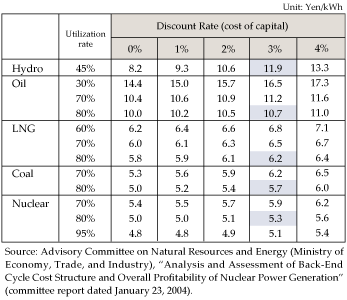
Table 2. Energy Cost Estimates by Source (statutory depreciation life)
Operational life: Hydro 40 yrs, oil 15 yrs, LNG 15 yrs, coal 15 yrs, nuclear 16yrs
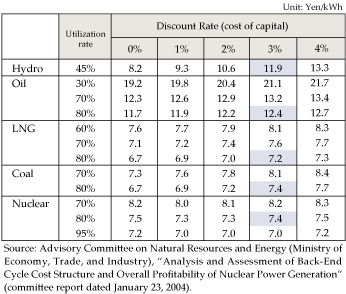
An International Perspective
Contrary to METI's calculations, Japan's electric power industry maintains that if the country's nuclear plants were shut down and conventional thermoelectric generators were used to make up the deficiency, the industry would be obliged to pay an extra 3 trillion yen in fuel costs, and electricity rates would jump by about 20%. The major reason for the gap between the two analyses is that METI's calculations include the cost of building new facilities. If we limit the discussion to existing facilities, then the industry's estimate is probably not too far off the mark.
Taking a broader view, however, we must ask why Japan, which depends on nuclear energy for 30% of its power needs, has conspicuously high electricity prices by international standards.
Figures 1 and 2 plot average electricity prices in selected industrial countries (with industrial rates on the left and residential rates on the right) against those countries' dependence on nuclear energy (percentage of total electricity generated). In Figure 1, local prices are converted to dollars on the basis of normal exchange rates. In Figure 2, the same prices are adjusted for purchasing power parity. Exchange rate–based values reflect short-term currency fluctuations and the yen's increasing strength against other currencies. PPP-based values are much less variable and are less affected by the yen's appreciation.
Converted to dollar terms using prevailing exchange rates, as in Figure 1, Japanese electricity prices appear even higher because of the strong yen, which reflects the high productivity of Japan's export industries. The lower PPP-based figures in Figure 2 more accurately reflect the economy's overall productivity. Thus, the gap between the exchange-rate-based prices in Figure 1 and the PPP-based prices in Figure 2 can be taken as an indicator of the productivity gap between the power industry and the economy as a whole.
Both Figure 1 and Figure 2 confirm at a glance that Japan's electricity rates, whether residential or industrial, are relatively high. A cursory inspection also seems to support the notion that a higher share of nuclear power correlates with lower electricity rates. However, as soon as one removes Italy from the mix, the correlation breaks down completely. We can confirm this statistically by calculating the coefficient of determination for nuclear power share with respect to lower electricity prices: Using exchange-rate-based figures, with Italy included in the calculations, R2 is 0.290 for industrial rates and 0.252 for residential rates; using PPP conversion, R2 is 0.290 for industrial rates and 0.227 for residential rates.
However, with Italy removed from the calculation, the coefficient of determination is only 0.040 for industrial prices and 0.0588 for residential prices when using exchange rates, and a mere 0.0003 and 0.009, respectively, when using PPP values.
Figure 1. Nuclear Energy Dependence and Electricity Prices (exchange-rate conversion)
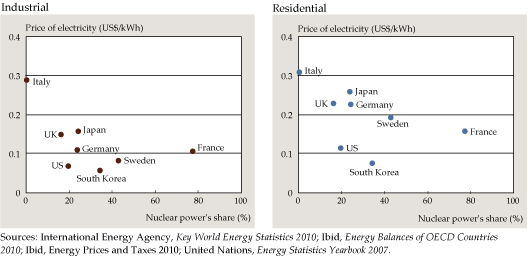
Figure 2. Nuclear Energy Dependence and Electricity Prices (PPP conversion)
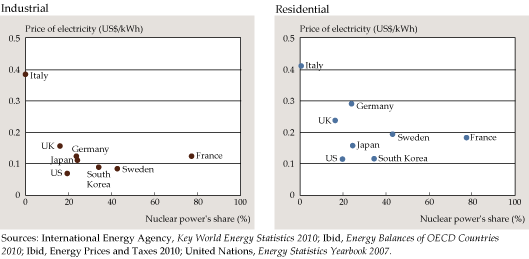
Has Nuclear Power Lowered Japan's Energy Prices?
Let us approach the same question from a historical perspective. Overall, Japan's electricity prices have fallen since the second half of the 1990s. But does that trend correlate with a relative increase in the contribution of nuclear power?
Figure 3 compares movements in Japan's electricity prices and its dependence on nuclear energy as opposed to conventional thermal power. In the chart, "residential" refers to power companies' so-called "meter-rate lighting" for households, while "industrial" represents the discounted rates for big industrial customers. In both categories, prices declined between 1998 and 2007.
During the same period, nuclear energy's share shrank, owing to circumstances that negatively affected capacity utilization of the country's nuclear plants (most notably the criticality accident at the Tokaimura nuclear fuel reprocessing facility in Ibaraki Prefecture in 1999, the rupture of a steam pipe at the Mihama Nuclear Power Station in Fukui Prefecture in 2004, and the earthquake-related accident at the Kashiwazaki-Kariwa Nuclear Power Station in Niigata in 2007).
If nuclear energy were really cheaper overall, we could expect a decline in dependence on nuclear energy to coincide with a rise in electricity prices. In fact, however, electricity prices declined even as the share of nuclear power shrank and the ratio of electricity generated by fossil-fuel-burning plants increased.
Figure 3. Electricity Prices and Nuclear Power Dependence
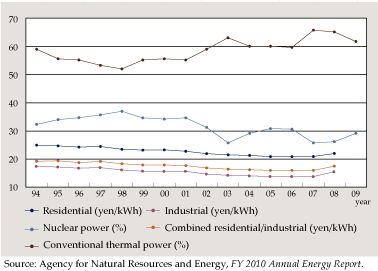
Between 1997 and 2008, residential meter rates fell 10.6%, from 24.49 yen to 21.89 yen per kWh; during the same period, the rate for major industrial customers dropped 9.3%, from 16.77 yen to 15.21 yen. (Although these figures suggest that the rate of decline was smaller for big industrial customers, the power companies are known to offer businesses individual discounts that make the actual price lower than the official rate.)
The cause of this drop in Japan's electricity rates was not nuclear power but the government's measures to open up the industry to competition. In 1995, regulators gave the green light to businesses known as independent power providers, permitting them to sell power to the general electric utilities or supply it directly to large customers. In addition, the minimum power consumption requirement for large customers was incrementally reduced (from 2,000 kW to just 50 kW today).
However, because the IPPs were obliged to pay the existing electric utilities for the use transmission lines, their profits were limited, thus discouraging new businesses from entering the market. As a result, the share of IPP-supplied power never exceeded 1%. Even within these limitations, however, prices fell by 10% thanks to increased competition.
With operations currently halted at a number of Japanese nuclear facilities, the price of fossil fuels has been rising and exerting upward pressure on electricity rates. If the government were to open the industry to additional competition, it would surely go a long way toward moderating the increase in electricity prices.
Conventional thermal power generation is inherently inefficient in the sense that a large portion of the heat generated by combustion is wasted. But new systems designed to recover and reuse heat can boost thermal efficiency significantly. Energy costs for LNG-fired plants are already as low as those for nuclear power facilities, and it should be possible to reduce the cost even further through the application of highly efficient combined-cycle cogeneration systems.
In these systems, exhaust heat from a gas-turbine generator is used to generate steam to power a steam-turbine generator, while hot water from the cooling system is used for community heating. Unlike nuclear power stations, which are located far from populations centers, cogeneration facilities can be safely built in urban areas, making them accessible for such community heating schemes. More efficient use of fossil fuels naturally means lower carbon dioxide emissions.
There are many in Japan even now who maintain that nuclear energy is the only way. Others cling to the hope of renewable energy while urging people to turn off their air conditioners. It seems to me that what we really need to do is open up the electric power industry to businesses and people who can inject it with new ideas and technologies. But the first step to designing sensible energy policies is to develop realistic and accurate energy cost estimates to lay the foundation for a meaningful national debate.
[i] http://www.meti.go.jp/policy/electricpower_partialliberalization/contentscost.html
